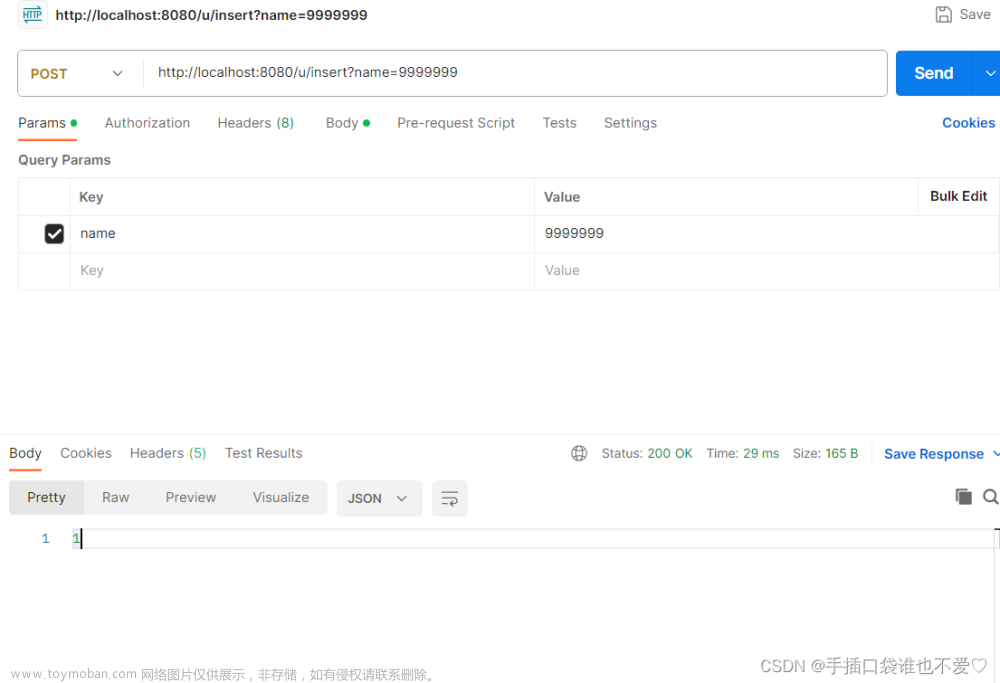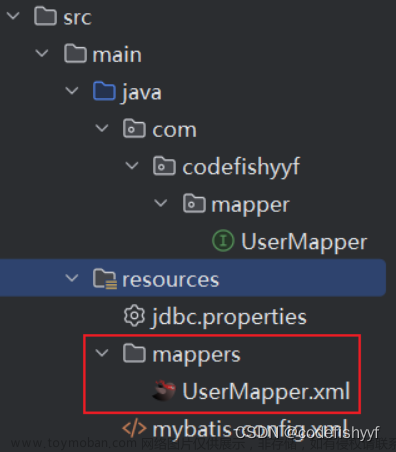学习完Mybatis的基本操作之后,继续学习Mybatis—XML配置文件、动态SQL。
Mybatis的XML配置文件
Mybatis的开发有两种方式:
- 注解
- XML
之前学习的基本操作都是基于注解开发。使用Mybatis的注解方式,主要是来完成一些简单的增删改查功能。如果需要实现复杂的SQL功能,建议使用XML来配置映射语句,也就是将SQL语句写在XML配置文件中。
XML配置文件规范
在Mybatis中使用XML映射文件方式开发,需要符合一定的规范:
1. XML映射文件的名称与Mapper接口名称一致,并且将XML映射文件和Mapper接口放置在相同包下
(同包同名)
2. XML映射文件的namespace属性为Mapper接口全限定名一致
3. XML映射文件中sql语句的id与Mapper接口中的方法名一致,并保持返回类型一致。

<select>标签:就是用于编写select查询语句的。
resultType属性,指的是查询返回的单条记录所封装的类型。
XML配置文件实现
第1步:创建XML映射文件

切记!: 在resource创建包时要用/分割符,如com/itheima/mapper,这样才是在resource文件夹下创建了com文件夹,然后com文件夹里创建了itheima文件夹,如果创建包时复制路径选错,选择复制了引用:com.itheima.mapper,那就只是在resource下创建了一个名字为“com.itheima.mapper”的子包,这样系统就会报错找不到XML映射文件!


第2步:编写XML映射文件
xml映射文件中的dtd约束,直接从mybatis官网复制即可:
<?xml version="1.0" encoding="UTF-8" ?>
<!DOCTYPE mapper
PUBLIC "-//mybatis.org//DTD Mapper 3.0//EN"
"https://mybatis.org/dtd/mybatis-3-mapper.dtd">
<mapper namespace="">
</mapper>
配置:XML映射文件的namespace属性为Mapper接口全限定名

<?xml version="1.0" encoding="UTF-8" ?>
<!DOCTYPE mapper
PUBLIC "-//mybatis.org//DTD Mapper 3.0//EN"
"https://mybatis.org/dtd/mybatis-3-mapper.dtd">
<mapper namespace="com.itheima.mapper.EmpMapper">
</mapper>
配置:XML映射文件中sql语句的id与Mapper接口中的方法名一致,并保持返回类型一致

最终xml:
<?xml version="1.0" encoding="UTF-8" ?>
<!DOCTYPE mapper
PUBLIC "-//mybatis.org//DTD Mapper 3.0//EN"
"https://mybatis.org/dtd/mybatis-3-mapper.dtd">
<mapper namespace="com.itheima.mapper.EmpMapper">
<!--查询操作-->
<select id="list" resultType="com.itheima.pojo.Emp">
select * from emp
where name like concat('%',#{name},'%')
and gender = #{gender}
and entrydate between #{begin} and #{end}
order by update_time desc
</select>
</mapper>
将Mapper接口中的select注解注释掉,只保留接口方法,运行测试类可发现与上一节中使用注解查询的方法运行结果相同。
MybatisX的使用
MybatisX是一款基于IDEA的快速开发Mybatis的插件,为效率而生。
MybatisX的安装:

可以通过MybatisX快速定位:

MybatisX的使用在后续学习中会继续分享
Mybatis动态SQL
SQL语句会随着用户的输入或外部条件的变化而变化,我们称为:动态SQL。
在页面原型中,列表上方的条件是动态的,是可以不传递的,也可以只传递其中的1个或者2个或者全部:


而在我们刚才编写的SQL语句中,我们会看到,我们将三个条件直接写死了。 如果页面只传递了参数姓名name 字段,其他两个字段 性别 和 入职时间没有传递,那么这两个参数的值就是null:

正确的做法应该是:传递了参数,再组装这个查询条件;如果没有传递参数,就不应该组装这个查询条件。
比如:如果姓名输入了"张", 对应的SQL为:
select * from emp where name like '%张%' order by update_time desc;
如果姓名输入了"张",,性别选择了"男",则对应的SQL为:
select * from emp where name like '%张%' and gender = 1 order by update_time desc;
在Mybatis中提供了很多实现动态SQL的标签,我们学习Mybatis中的动态SQL就是掌握这些动态SQL标签。

动态SQL-if
<if> :用于判断条件是否成立。使用test属性进行条件判断,如果条件为true,则拼接SQL。
<if test="条件表达式">
要拼接的sql语句
</if>
条件查询 <if>与<where>
- 原有的SQL语句
<select id="list" resultType="com.itheima.pojo.Emp">
select * from emp
where name like concat('%',#{name},'%')
and gender = #{gender}
and entrydate between #{begin} and #{end}
order by update_time desc
</select>
- 动态SQL语句
<select id="list" resultType="com.itheima.pojo.Emp">
select * from emp
where
<if test="name != null">
name like concat('%',#{name},'%')
</if>
<if test="gender != null">
and gender = #{gender}
</if>
<if test="begin != null and end != null">
and entrydate between #{begin} and #{end}
</if>
order by update_time desc
</select>
PS:
如果判断的类型是字符串类型最好加上空字符串判断,如:
<if test="username != null and username != ''">
username = #{username},
</if>
测试方法:
@Test
public void testList(){
//性别数据为null、开始时间和结束时间也为null
List<Emp> list = empMapper.list("张", null, null, null);
for(Emp emp : list){
System.out.println(emp);
}
}

下面修改测试方法中的代码,再次进行测试,观察执行情况:
@Test
public void testList(){
//姓名为null
List<Emp> list = empMapper.list(null, (short)1, null, null);
for(Emp emp : list){
System.out.println(emp);
}
}


再次修改测试方法中的代码,再次进行测试:
@Test
public void testList(){
//传递的数据全部为null
List<Emp> list = empMapper.list(null, null, null, null);
for(Emp emp : list){
System.out.println(emp);
}
}

以上问题的解决方案:使用<where> 标签代替SQL语句中的where关键字。
<where> 只会在子元素有内容的情况下才插入where子句,而且会自动去除子句的开头的AND或OR
<select id="list" resultType="com.itheima.pojo.Emp">
select * from emp
<where>
<!-- if做为where标签的子元素 -->
<if test="name != null">
and name like concat('%',#{name},'%')
</if>
<if test="gender != null">
and gender = #{gender}
</if>
<if test="begin != null and end != null">
and entrydate between #{begin} and #{end}
</if>
</where>
order by update_time desc
</select>
测试方法:
@Test
public void testList(){
//只有性别
List<Emp> list = empMapper.list(null, (short)1, null, null);
for(Emp emp : list){
System.out.println(emp);
}
}

更新员工 <set>
动态更新员工信息,如果更新时传递有值,则更新;如果更新时没有传递值,则不更新
解决方案:动态SQL
修改Mapper接口:
@Mapper
public interface EmpMapper {
//删除@Update注解编写的SQL语句
//update操作的SQL语句编写在Mapper映射文件中
public void update(Emp emp);
}
修改Mapper映射文件:
<?xml version="1.0" encoding="UTF-8" ?>
<!DOCTYPE mapper
PUBLIC "-//mybatis.org//DTD Mapper 3.0//EN"
"https://mybatis.org/dtd/mybatis-3-mapper.dtd">
<mapper namespace="com.itheima.mapper.EmpMapper">
<!--更新操作-->
<update id="update">
update emp
set
<if test="username != null">
username=#{username},
</if>
<if test="name != null">
name=#{name},
</if>
<if test="gender != null">
gender=#{gender},
</if>
<if test="image != null">
image=#{image},
</if>
<if test="job != null">
job=#{job},
</if>
<if test="entrydate != null">
entrydate=#{entrydate},
</if>
<if test="deptId != null">
dept_id=#{deptId},
</if>
<if test="updateTime != null">
update_time=#{updateTime}
</if>
where id=#{id}
</update>
</mapper>
测试方法:
@Test
public void testUpdate2(){
//要修改的员工信息
Emp emp = new Emp();
emp.setId(20);
emp.setUsername("Tom222");
//调用方法,修改员工数据
empMapper.update(emp);
}

以上问题的解决方案:使用<set> 标签代替SQL语句中的set关键字
<set> :动态的在SQL语句中插入set关键字,并会删掉额外的逗号。(用于update语句中)
<?xml version="1.0" encoding="UTF-8" ?>
<!DOCTYPE mapper
PUBLIC "-//mybatis.org//DTD Mapper 3.0//EN"
"https://mybatis.org/dtd/mybatis-3-mapper.dtd">
<mapper namespace="com.itheima.mapper.EmpMapper">
<!--更新操作-->
<update id="update">
update emp
<!-- 使用set标签,代替update语句中的set关键字 -->
<set>
<if test="username != null">
username=#{username},
</if>
<if test="name != null">
name=#{name},
</if>
<if test="gender != null">
gender=#{gender},
</if>
<if test="image != null">
image=#{image},
</if>
<if test="job != null">
job=#{job},
</if>
<if test="entrydate != null">
entrydate=#{entrydate},
</if>
<if test="deptId != null">
dept_id=#{deptId},
</if>
<if test="updateTime != null">
update_time=#{updateTime}
</if>
</set>
where id=#{id}
</update>
</mapper>
再次执行测试方法,执行的SQL语句:

小结
-
<if>-
用于判断条件是否成立,如果条件为true,则拼接SQL
-
形式:
<if test="name != null"> … </if>
-
-
<where>- where元素只会在子元素有内容的情况下才插入where子句,而且会自动去除子句的开头的AND或OR
-
<set>- 动态地在行首插入 SET 关键字,并会删掉额外的逗号。(用在update语句中)
动态SQL-<foreach>
案例:员工删除功能(既支持删除单条记录,又支持批量删除)
SQL语句:
delete from emp where id in (1,2,3);
Mapper接口:
@Mapper
public interface EmpMapper {
//批量删除
public void deleteByIds(List<Integer> ids);
}
XML映射文件:
- 使用
<foreach>遍历deleteByIds方法中传递的参数ids集合
<foreach collection="集合名称" item="集合遍历出来的元素/项" separator="每一次遍历使用的分隔符"
open="遍历开始前拼接的片段" close="遍历结束后拼接的片段">
</foreach>
<?xml version="1.0" encoding="UTF-8" ?>
<!DOCTYPE mapper
PUBLIC "-//mybatis.org//DTD Mapper 3.0//EN"
"https://mybatis.org/dtd/mybatis-3-mapper.dtd">
<mapper namespace="com.itheima.mapper.EmpMapper">
<!--删除操作-->
<delete id="deleteByIds">
delete from emp where id in
<foreach collection="ids" item="id" separator="," open="(" close=")">
#{id}
</foreach>
</delete>
</mapper>

测试类:
@SpringBootTest
class SpringbootMybatisCrudApplicationTests {
@Autowired
private EmpMapper empMapper;
@Test
public void testUpdate2(){
//要修改的员工id
List<Integer> ids = Arrays.asList(1,2,3);
//调用方法,修改员工数据
empMapper.deleteByIds(ids);
}
}
执行的SQL语句:

动态SQL-<sql>&<include>
问题:在xml映射文件中配置的SQL,有时可能会存在很多重复的片段,此时就会存在很多冗余的代码


我们可以对重复的代码片段进行抽取,将其通过<sql>标签封装到一个SQL片段,然后再通过<include>标签进行引用。
-
<sql>:定义可重用的SQL片段 -
<include>:通过属性refid,指定包含的SQL片段

SQL片段: 抽取重复的代码
然后通过<include> 标签在原来抽取的地方进行引用。
<?xml version="1.0" encoding="UTF-8" ?>
<!DOCTYPE mapper
PUBLIC "-//mybatis.org//DTD Mapper 3.0//EN"
"https://mybatis.org/dtd/mybatis-3-mapper.dtd">
<mapper namespace="com.itheima.mapper.EmpMapper">
<sql id="commonSelect">
select id, username, password, name, gender, image, job, entrydate, dept_id, create_time, update_time from emp
</sql>
<select id="list" resultType="com.itheima.pojo.Emp">
<include refid="commonSelect"/>
<where>
<if test="name != null">
name like concat('%',#{name},'%')
</if>
<if test="gender != null">
and gender = #{gender}
</if>
<if test="begin != null and end != null">
and entrydate between #{begin} and #{end}
</if>
</where>
order by update_time desc
</select>
</mapper>
动态SQL中的特殊符号(大于,小于,不等于)使用注意事项
大于(>,>=)、小于(<,<=)、不等于(<> ,!=)符号包含了尖括号,Mybatis使用的 *.xml文件格式。于是需要进行相关的转义或者使用 CDATA 区段。严格地讲,在 XML 中仅有字符 “<“和”&” 是非法的。省略号、引号和大于号是合法的,但是把它们都替换为实体引用是个好的习惯。文章来源:https://www.toymoban.com/news/detail-736314.html
可以参考java特殊文件 属性文件properties和XML文件,和Mybatis 特殊符号(大于,小于,不等于)及常用函数总结文章来源地址https://www.toymoban.com/news/detail-736314.html
到了这里,关于Mybatis—XML配置文件、动态SQL的文章就介绍完了。如果您还想了解更多内容,请在右上角搜索TOY模板网以前的文章或继续浏览下面的相关文章,希望大家以后多多支持TOY模板网!













